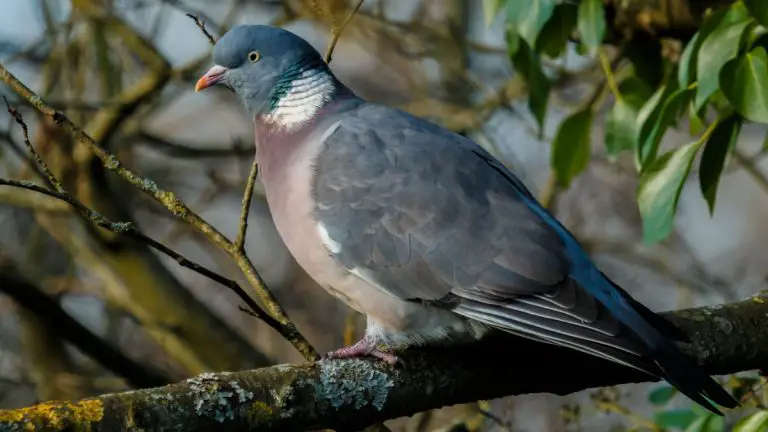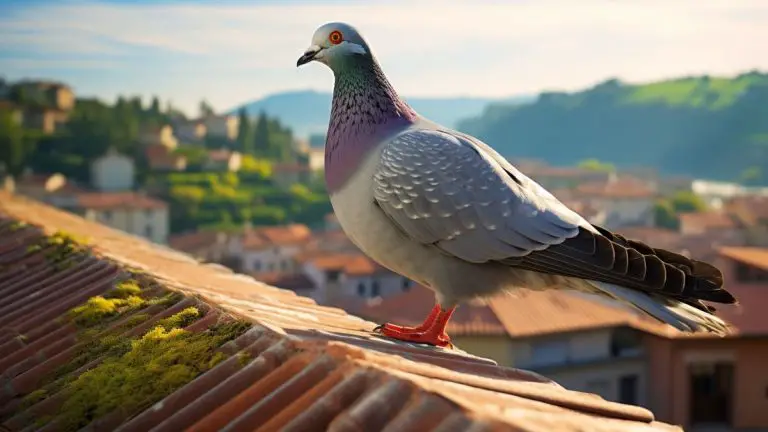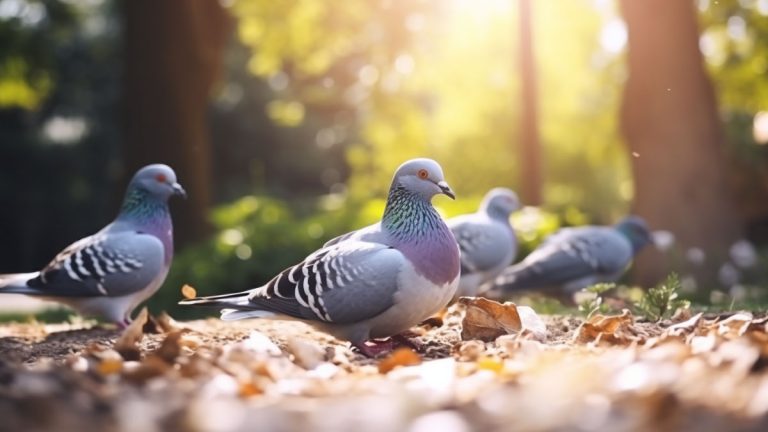Chinese Owl Pigeon: Origin, Appearance, Behavior, Care, And More
Chinese owl pigeon strikes an appearance of a bold, upright, and alert pigeon. It has its breast threw out prominently and eyes sitting perpendicular on a line to the ball of its feet. Not to forget the natural frills on its breast and neck.
All these qualities give the bird an edge in movement, composition, and expression—making it a highly prized breed for shows and exhibitions.
This article will dig out more about the Chinese owl pigeon. You’ll discover this bird’s history and origin, a detailed physical description, its behavior, temperament, habitat, diet, suitability as a pet, and so much more.
Chinese Owl Pigeon Quick Facts
| Scientific name | Columba livia domestica |
| Other names | Whiskered Owl Pigeon |
| Breed name | Chinese Owl |
| Origin | Spain/India |
| Breed purpose | Exhibition, pets |
| Size | Medium |
| Weight | 280 to 340 grams |
| Flying ability | Average |
| Cost | $50 to $500+ |
| Lifespan | 10+ years |
Origin and history
Don’t let the name deceive you. The fancy breed that goes by the name Chinese owl pigeon isn’t from china. Instead, the bird’s origin is uncertain. But it is believed to have been developed in Spain and India.
The “chinse owl” name came from a French pigeon dealer who had the birds in Paris. He sold some of the birds to King Porsche of Germany around 1865 who then spent his entire life breeding them, leading to the development of the unique Chinese owl breed of pigeons known today.
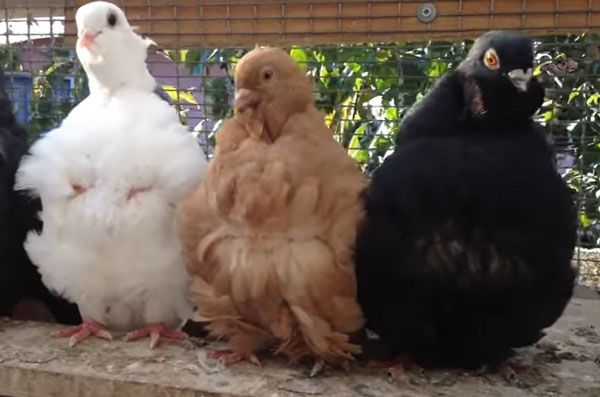
This means Germany is heavily credited with the early development of this breed. Today, you can find this pigeon pretty much anywhere in the world.
The bird is a result of years of selective breeding and is a descendant of the rock dove, like many other domesticated breeds of pigeon.
Chinese owl pigeon was developed through crossbreeding of the Spanish chorrera pigeon.
Appearance
Chinese owl pigeons are medium-sized birds. They get their name “owl pigeons” from their short beak and rounded head, which are similar to that of an owl.
These birds are characterized by a fairly abundant amount of feathering and a frill pattern of feathers on the front of their thighs.
They have a distinct frill starting on their chest and running all the way up to the sides of their cheeks (hence, they also go by the name Whiskered Owl Pigeon).
Head is usually arched from the back side of the beak to form a smooth profile. The bird’s width is equally proportioned and they have a broad appearance.
Regarding the eyes, the white variety has blue eyes while other color varieties feature red or red-orange colored eyes.
The eye cere appears fine and smooth and perfectly follows the eye contour. The cere is dark in blue, black, and checked birds but appears as a light shade in other color varieties. White pigeons have a flesh-looking cere.
The pigeons have a short neck that’s thick at the shoulder and tapers to the back of head to form a smooth profile.
Though dainty, the beak of Chinese owl pigeons is large enough to distinguish this breed from the African owl pigeon breed.
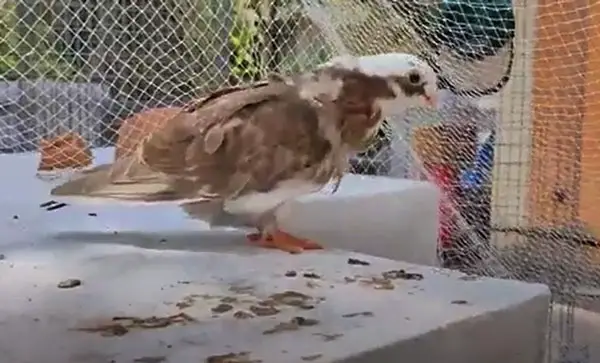
The beak is usually black for blue, blue-checkered, and black birds. However, it is light horn colored for silver, silver checked, dun, and silver dun-colored birds.
And it appears flesh for birds with red, yellow, and white coloration. The beak usually sits at about 120- degrees with the bird’s head forepart.
Chinese owl pigeon neck frills appear as smooth and even collars comprised of revered feathers that fit loosely relative to the neck.
The frill breaks behind the neck in a vertical line that leaves a gap of approx. quarter-inch on the back of head. This should go as high as the lower end of the bird’s eye cere.
Breast frills feature a lavish set of reversed feathers covering the breast area completely. The feathers here are directed downward to the pantaloons and upwards to the neck frill.
These frills cover the forepart of the wing down to pantaloons and even the wing butts. This frill appears proportional on both sides.
The pigeon has short and colored legs, free of feathers from below the hock. Its feet are also pretty small and neat and the toes appear well spread apart.
Behavior
The Chinese owl pigeons are generally passive birds and are quite friendly and social. They can be kept in pairs or with other flocks of birds without worrying about fighting.
However, you should keep in mind that male Chinese owl pigeons are quite territorial. As such, you’d want to ensure you provide enough food, water, and space in their housing.
You’d also want to consider providing each pair with its own breeding space away from other pairs.
These birds are free flyers and can do it fairly well, though not as good as racer pigeons.
However, if you plan to keep these birds for shows and exhibitions, then you should keep them in their lofts and not fly them to help preserve their breast feathers and frills.
Diet
Chinese owl pigeon diet involves grains, seeds, vegetables, and fruits. However, keep in mind that their short beaks make them unable to feed on the larger seeds such as large sunflower seeds and pea seeds. As such, we recommend giving them a roller or tumbler mix to ensure food doesn’t go to waste.
Chinese owl pigeons as pets
This breed is also suitable for beginners due to its low maintenance which makes it easy to care for. They’re also docile and friendly birds and will enjoy socializing with fellow birds as well as with their owners.
That said, you need to keep a few things in mind before getting this pigeon breed for a pet. Firstly, you should provide your pigeon with clean and spacious housing that provides them with plenty of room to move around.
The aviary should be well-ventilated and proofed against harsh weather elements as well as predators. It should also provide your birds with suitable nesting or roosting areas.
You’ll need to clean the space regularly to keep away infections from catching up with your birds.

Provide your birds with a balanced diet that includes quality birdseed mix. Vegetables and fruits can also help add variety to your bird’s diet. Additionally, provide your bird with clean, fresh water daily.
These pigeons are sociable and will appreciate it if you keep them in pairs or in a small groups. Interacting with them regularly will also keep them happy.
To keep your birds healthy, you’ll need to get an avian vet to examine them regularly and administer the necessary vaccinations.
Breeding guide
Breeding Chinese owl pigeons is possible and pretty easy. They’re reliable parents and will take care of their young ones until they’re old enough to survive on their own.
For successful breeding, you first want to ensure you pair a male and female Chinese owl pigeon. Needless to say, the individual birds should be of breeding age and in good health.

Provide your birds with a suitable nesting area for laying eggs. Females typically lay two eggs per clutch which then take around 17 to 19 days to hatch.
The pair will give their offspring the necessary care and attention until they reach an age they can depend on themselves.
Price
The cost of a Chinese owl pigeon can be anywhere from $50 to several hundred dollars. However, the exact price can vary depending on a variety of factors such as the location, breeder, quality of the breed you’re buying, age, etc.
Some rare color variations will also cost you more as this is a desirable quality for pigeons in shows and competitions.
When buying a Chinese owl pigeon, we advise you to research well to find a reputable breeder who will sell you a healthy, well-cared-for pigeon without any defects at a good price.
Lifespan
The lifespan of a Chinese owl pigeon is about 10 years, though some birds can live even longer with good care.
Generally, the life expectancy of your pigeon is affected by factors such as genetics, living conditions, diet, and overall care they get from their owners.
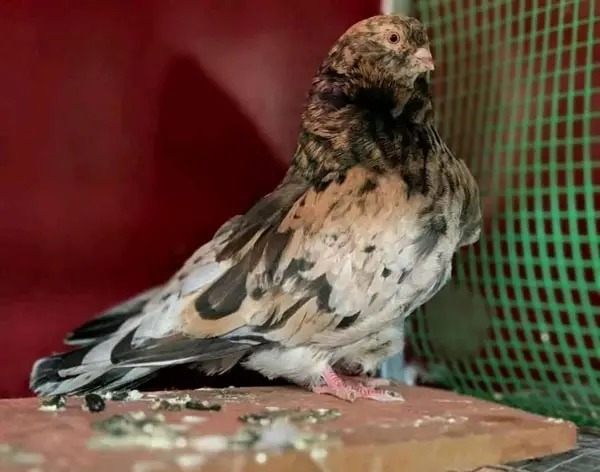
To ensure your pigeons live a long life, provide them with proper nutrition and keep them in spacious and hygienic housing.
Regular checkups with an avian vet will also help catch any potential health issues in your pigeons, helping extend their lifespan.
If you’re interested in learning about other unique breeds of pigeons, you might want to check out our articles on Carneau pigeons and African Owl pigeons. Our article on Carneau pigeons provides an in-depth look at the history, characteristics, and care requirements of these elegant and friendly birds, including how to maintain their health and well-being. Meanwhile, our article on African Owl pigeons explores the unique features and care requirements of these fascinating birds, including how to raise and maintain their health and well-being.Final Verdict
Chinese owl pigeons are a fancy breed of pigeons that trace their origin to Germany. These birds have round heads with short beaks which give them the name owl pigeons. They have distinctive frill feathers on their chest and belly and multiple color varieties. These give the birds an elegant appearance and make them popular breeds for shows and competitions involving pigeons. Chinese owl pigeons are friendly and docile, so you can keep them as pets with proper care. Provide your bids with a balanced diet, spacious and clean living space, plenty of socialization opportunities, and regular vet checkups to keep them happy and healthy.

